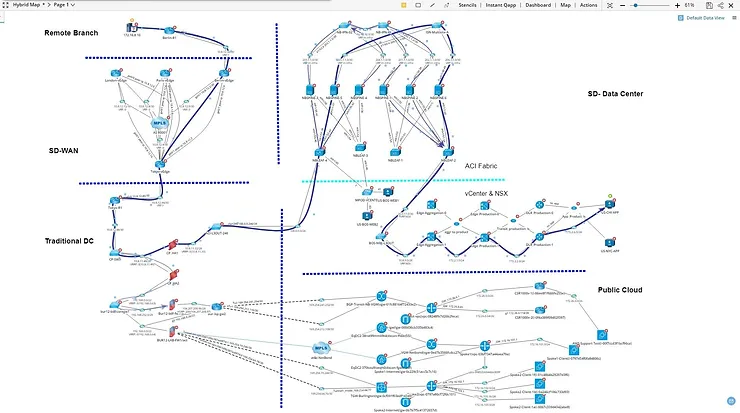Ensuring Seamless Device Failover with Network Automation: A Comprehensive Guide
.webp?width=740&height=429&name=5a16f9_33ca95b4931b4abc8b2eb1dcac3f186a~mv2%20(1).webp)
In today's world, network and infrastructure reliability is critical. Businesses and organizations depend on robust, complex and hybrid networks to ensure continuous operations and seamless user experiences.
One critical aspect of maintaining network resilience is utilizing device failover. Most organizations already implement some form of device failover within their infrastructure environment, but most organizations are too busy to consistently and proactively validate and test these failovers.
So what is the importance of device failover readiness and how can network automation can be a game-changer in ensuring a smooth transition during unforeseen events?
Understanding Device Failover Readiness:
The Significance of Redundancy:
Device redundancy involves having backup systems or components ready to take over in case of a primary device failure. This redundancy is a key component of high-availability networks, minimizing downtime and preventing service disruptions. A network or infrastructure outage can cost an organization thousands to millions of dollars.
To calculate a very rough estimated outage cost you can run the formula:
If open 24/7/265 – $1 Million/ 8760 = $114 per hour, per million of revenue
If open 8 AM – 5 PM, Monday – Friday - $1 Million/2080 = $480 per hour per million of revenue.
So even for a business that is doing $100 Million, $11,400 per hour at minimum and up to 48,000 per hour. More than likely this number would be higher depending on outage time, area of outage, how many and type of employees affected, etc.
Challenges in Manual Failover Testing:
On-going testing is essential to ensure that failover happens when it needs to happen, as we all know our infrastructure environments do not stay stagnet. Traditionally, ensuring device failover readiness has been a manual and time-consuming process. It often involves downtime, potential service disruptions, and the risk of human error. Network administrators need a more efficient and reliable method to validate failover mechanisms without impacting ongoing operations.
Leveraging Network Automation:
Automated Configuration Management:
Network automation tools can streamline the management of device configurations. By automating the backup and synchronization of configurations across redundant devices, administrators can ensure that failover devices are always up-to-date and ready to take over seamlessly.
Continuous Monitoring and Health Checks:
Implementing automated monitoring and health checks enables administrators to assess the real-time status of network devices. Automated scripts can regularly test the health of redundant devices, ensuring that they meet predefined criteria for failover readiness. This proactive approach helps identify potential issues before they escalate.
Simulated Failover Testing:
Automation allows for the creation of simulated failover scenarios without impacting the production environment. By scripting controlled failover tests, administrators can assess how well redundant devices respond to failures and validate the effectiveness of failover configurations.
Reporting and Analysis:
Automation tools can generate comprehensive reports on the results of failover tests, providing insights into the network's overall resilience. These reports help administrators identify areas for improvement, refine failover configurations, and ensure that the network is adequately prepared for unexpected events.
Implementing Network Automation for Device Failover Readiness:
Choose the Right Automation Tools:
It is always important to select automation tools that aligns with your network infrastructure and requirements. Over the past few years, most organizations have implemented popular tools including Ansible, Puppet, or custom scripts tailored to your specific needs. There are also marketplace tools that provide libraries to assist in more quickly in implementing automations.
Define Failover Criteria:
The other key items with automation or monitoring is to properly establish clear criteria for failover readiness, considering factors such as latency, packet loss, and device health. These criteria will serve as benchmarks for automated failover testing.
Regularly Update and Test Automation Scripts:
Keep automation scripts up-to-date with changes in the network environment. Regularly test scripts to ensure they accurately reflect the failover process and accommodate any updates or modifications.
Document and Review Results:
Maintain detailed documentation of failover tests and results. Regularly review this documentation to identify trends, patterns, or areas requiring improvement.
In a world where network downtime can have significant consequences, the proactive approach of using network automation for device failover readiness is indispensable. By leveraging automated tools, documentation and reporting, organizations can enhance the reliability and resilience of their networks. This ensures a seamless transition during the most critical moments.
Is it time for your organization to embrace the power of automation to stay ahead in today's fast-paced and interconnected digital landscape?
Vsol offers managed services around network automation and management. Many organizations struggle with having the team member availability or skill sets to implement and maintain the management and support of their infrastructure. Vsol provides the tools, processes and people to quickly implement, provide continuous assessments and drive automation to reduce the service cost each year. Reach out for more information.

